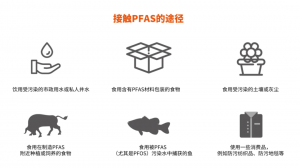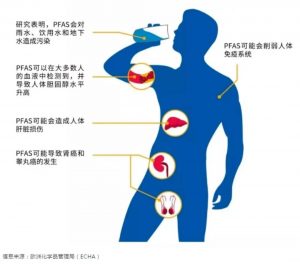Recently, the results of an investigation in Okayama Prefecture, Japan, revealed elevated levels of organic fluorine compounds in the blood of some residents in the central area of Kibiji, posing a threat to their health. Analysts speculate that this may be related to their long-term consumption of tap water containing high concentrations of per- and polyfluoroalkyl substances (PFAS).

PFAS are difficult to degrade and accumulate in the environment and the human body, earning them the title of “persistent chemicals.” Experts point out that long-term ingestion of water contaminated with these substances may affect reproductive health and the growth and development of children, and may even lead to diseases such as breast cancer and prostate cancer.

Seeing this, are you also shocked?
What exactly are per- and polyfluoroalkyl substances?
How do they enter the bloodstream?
What harm do they cause to the human body?
What are Per- and Polyfluoroalkyl Substances (PFAS)? PFAS are a class of special synthetic organic compounds primarily composed of carbon and fluorine atoms. They not only have hydrophilic functional groups and hydrophobic alkyl side chains but also possess fire resistance, high stability, and persistence. Therefore, they are widely used in various industries such as textiles, surfactants, food packaging, non-stick coatings, and firefighting foams. Due to their high thermal and chemical stability, they can persist in the environment and are almost not biodegradable. Among the various types of PFAS, perfluorooctanesulfonic acid (PFOS) and perfluorooctanoic acid (PFOA) are the most common types.
Routes of PFAS Intake into the Human Body Studies from various countries have shown that dietary intake is the main route of human exposure to PFAS. Perfluorinated compounds can enter the body through diet, drinking water, and respiration. Once ingested by organisms, they do not accumulate in adipose tissue but bind to proteins and exist in the blood. They accumulate in organs such as the liver, kidneys, and muscles, showing significant bioaccumulation.

Effects of PFAS on Our Health The potential health hazards of PFAS to the human body have always been a focus of research. There is abundant evidence to suggest that exposure to PFAS can have adverse health effects on humans, including organ toxicity, immune toxicity, endocrine toxicity, neurotoxicity, reproductive and developmental toxicity, and even carcinogenicity and carcinogenic promotion.

A birth cohort study from Denmark found that elevated concentrations of PFOS and PFOA in maternal serum during pregnancy increased the risk of congenital cerebral palsy in male offspring, showing a dose-response relationship. PFOA and PFOS can also cause newborns to have lower birth weights and smaller body sizes, decrease male sperm count, disrupt endocrine function, and have carcinogenic effects. They are also associated with thyroid diseases.
Control Process for PFAS Compounds The hazards of perfluoro compounds to human health and the environment have attracted widespread attention from relevant countries and international organizations, and more and more perfluoro compounds have been or are about to be included in regulatory control. As early as 2009, PFOS and its salts and related substances were included in the list of the Stockholm Convention on Persistent Organic Pollutants (POPs). In 2019, PFOA and its salts and related substances were included, and in 2022, PFHxS and its salts and related substances were included.
At the same time, PFAS substances have been successively included in priority lists for import and export control, lists of zero-discharge of hazardous substances, and lists of high-concern substances. In the “Key Controlled New Pollutant List (2023 Edition)”, perfluorooctanesulfonic acid and its salts and perfluorooctanesulfonyl fluoride (PFOS class), perfluorooctanoic acid and its salts and related compounds (PFOA class), and perfluorohexane sulfonic acid and its salts and related compounds (PFHxS class) have been included.
On May 4, 2022, the State Council issued the “Action Plan for New Pollutants”, proposing to complete the screening and risk assessment of a batch of substances by the end of 2025 and establish a governance system for the screening, assessment, and control of new pollutants. It requires laboratories with the capability to establish corresponding detection capabilities as soon as possible to meet the needs of scientific research and supervision.


